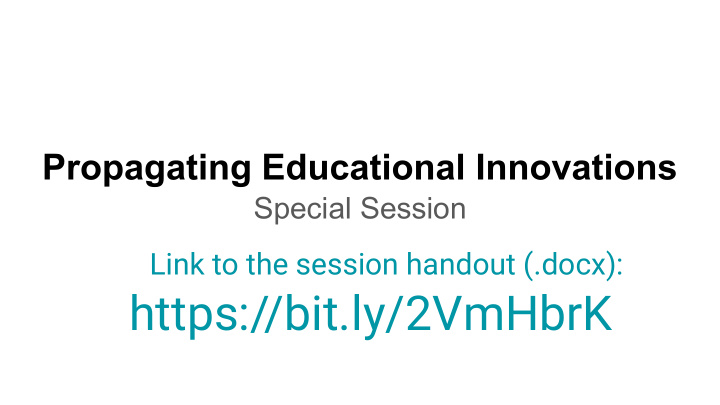



Propagating Educational Innovations Special Session Link to the session handout (.docx): https://bit.ly/2VmHbrK
People aren’t planning for propagation. It doesn’t happen on its own.
Outline Introduction Form Groups Breakout Sessions (brainstorming, sharing) ● Motivating potential adopters ● Challenges/obstacles to adoption ● Addressing challenges/obstacles Summary
Who We Are lTiCSE ‘18 Larnaca, Cyprus Heather Bort Marquette University David P. Bunde Knox College Zack Butler Rochester Institute of Technology Christopher Lynnly Hovey University of Colorado Boulder Cynthia Taylor Oberlin College ...and the rest of our Working Group.
Definitions ● Innovation: Any novel teaching technique, strategy, tool, or learning resource that could be used by an instructor ● Dissemination: Raising awareness about an innovation ● Propagation: Increasing the user base of an innovation
Learning Outcomes After our session, attendees will be able to: ● Identify individual, social, and institutional barriers that can prevent propagation ● Articulate some strategies for overcoming those barriers ● Find useful, high-level resources from which to get more information
Group formation (7 minutes) ● Form small groups (3-4 people) ● Have each person introduce themselves: ○ Name, affiliation, type of classes you teach, etc. ○ If you have time: Why are you here? What are you hoping to get out of this session? What innovations have you personally adopted? … have you considered but then decided not to adopt? … tried to propagate?
Motivating potential adopters (about 10 min) Think about an innovation you’ve adopted or considered adopting. ● What were your goals with adopting this innovation? ● How did you find out about a particular innovation? ● What convinced you to try it?
Brainstorm: Motivating Potential Adopters ● Clear instruction and stress the ease of adoption ● Support for adopters ● Reduced workload ● Administrative/institutional buy-in ● Support for motivated people vs motivation of questioning people ● Evidence of learning outcomes should be enough, we need something more ● Highlight similarities to current practice ● Show how it can be integrated into current teaching
Motivating Potential Adopters ● Students’ learning and engagement ● Candid testimonials from colleagues ○ Teaching reputations, and contextual similarities ● Institutional rewards/incentives ● Formal training and ongoing support ● Address perceived challenges and obstacles Necessary, but insufficient: ● Attitudes towards lecturing (faculty know it’s not enough) ● Evaluations/publications
Brainstorm challenges/obstacles to adoption (~8 min) ● What challenges/obstacles have you experienced to adopting an educational innovation? ○ Individual barriers - Something related to yourself or your class ○ Institutional barriers - Aspects of your students, colleagues, department, institution
Challenges/obstacles to adoption (Group Brainstorm) PAGE 1 of 2 ● Student resistance, and consequently, evaluations ● Extra work , time to make new materials ● Content coverage, especially in prereqs ● Hard to justify adding innovations to an already innovative (or just generally good) course ● Money to make change and to sustain the change ● Lack of institutional support at research-oriented universities ● Lack of incentive (or worse!) at promotion/tenure ● Lack of motivation to improve student learning, or to meet students where they are
Challenges/obstacles to adoption (Group Brainstorm) PAGE 2 of 2 ● Longevity/sustainability of materials ● Not understanding (or having time to understand) the innovation ● Not understanding how to actually implement (or to implement well) ● Students not buying in to class activities, e.g. paired programming ● Lack of incentive for propagation, lack of measurement of propagation ● Challenge of coordination with colleagues, especially at different institutions
Challenges/obstacles to adoption reported in research ● Time to learn about, prep, and implement...so, setting priorities ● “Covering material” and curriculum sequencing ● Satisfaction with current teaching ● Familiarity with logistics and necessary resources ● Department policies (e.g., tenure and promotion, shared assignments, etc.) ● Department culture ● Physical classroom setup and enrollment size ● Having the necessary resources (infrastructure, TAs, etc.) ● “Fit” with other class procedures, pedagogy, and curriculum ● Students’ reactions to doing things in a new way (i.e., student feedback)
What can propagators do to address challenges? (~10 min) ● Time to learn about, prep, and implement...so, setting priorities ● “Covering material” and curriculum sequencing ● Satisfaction with current teaching ● Familiarity with logistics and necessary resources ● Department policies (e.g., tenure and promotion, shared assignments, etc.) ● Department culture ● Physical classroom setup and enrollment size ● Having the necessary resources (infrastructure, TAs, etc.) ● “Fit” with other class procedures, pedagogy, and curriculum ● Students’ reactions to doing things in a new way (i.e., student feedback)
What can propagators do to address challenges? (Brainstorm) ● Build a network of adopters ● Provide specific examples that are easy to implement ● Find their pain point and try to address that ● Find the right definition of success ● Keep pitching the ideas until it sinks in (entrepreneurial mindset) ● Show how to make small improvements at first - especially in the first 2 weeks ● Provide TAs ● Modeling the innovation in real time to show the adoption in practice ● Build a culture where risk-taking is accepted or even encouraged ● Show/imitate success stories of other innovations
Best Practices for Overcoming Challenges ● Plan for propagation. ● Plan for adaptation. ● Identify receptive faculty and speak to their needs. ● Involve a variety of champions. ● Support faculty during adoption. ● Build a network of users. ● Get institutional buy-in. ● Consider what resources will be needed. (for more info, see our handout)
For more information ● Chris’s talks: ○ Faculty adoption: Thurs 4:35-5pm ○ How frequently are certain practices actually used: Fri 11:35am-12pm ● Read our references: ○ Working Group report: “Propagating the adoption of CS educational innovations” ○ These slides from the session: https://bit.ly/2NkPzFw ○ Book: “Designing educational innovations for sustained adoption: A how-to guide for education developers who want to increase the impact of their work” by Henderson et al. ● Contact us: ○ Heather Bort - heather.bort@marquette.edu ○ David Bunde - dbunde@knox.edu ○ Zack Butler - zjb@cs.rit.edu ○ Chris Hovey - hoveyc@colorado.edu ○ Cynthia Taylor - cynthia.taylor@oberlin.edu
Recommend
More recommend